Zijian Zhao
Zero-Effort Image-to-Music Generation: An Interpretable RAG-based VLM Approach
Sep 26, 2025Abstract:Recently, Image-to-Music (I2M) generation has garnered significant attention, with potential applications in fields such as gaming, advertising, and multi-modal art creation. However, due to the ambiguous and subjective nature of I2M tasks, most end-to-end methods lack interpretability, leaving users puzzled about the generation results. Even methods based on emotion mapping face controversy, as emotion represents only a singular aspect of art. Additionally, most learning-based methods require substantial computational resources and large datasets for training, hindering accessibility for common users. To address these challenges, we propose the first Vision Language Model (VLM)-based I2M framework that offers high interpretability and low computational cost. Specifically, we utilize ABC notation to bridge the text and music modalities, enabling the VLM to generate music using natural language. We then apply multi-modal Retrieval-Augmented Generation (RAG) and self-refinement techniques to allow the VLM to produce high-quality music without external training. Furthermore, we leverage the generated motivations in text and the attention maps from the VLM to provide explanations for the generated results in both text and image modalities. To validate our method, we conduct both human studies and machine evaluations, where our method outperforms others in terms of music quality and music-image consistency, indicating promising results. Our code is available at https://github.com/RS2002/Image2Music .
Each to Their Own: Exploring the Optimal Embedding in RAG
Jul 23, 2025Abstract:Recently, as Large Language Models (LLMs) have fundamentally impacted various fields, the methods for incorporating up-to-date information into LLMs or adding external knowledge to construct domain-specific models have garnered wide attention. Retrieval-Augmented Generation (RAG), serving as an inference-time scaling method, is notable for its low cost and minimal effort for parameter tuning. However, due to heterogeneous training data and model architecture, the variant embedding models used in RAG exhibit different benefits across various areas, often leading to different similarity calculation results and, consequently, varying response quality from LLMs. To address this problem, we propose and examine two approaches to enhance RAG by combining the benefits of multiple embedding models, named Mixture-Embedding RAG and Confident RAG. Mixture-Embedding RAG simply sorts and selects retrievals from multiple embedding models based on standardized similarity; however, it does not outperform vanilla RAG. In contrast, Confident RAG generates responses multiple times using different embedding models and then selects the responses with the highest confidence level, demonstrating average improvements of approximately 10% and 5% over vanilla LLMs and RAG, respectively. The consistent results across different LLMs and embedding models indicate that Confident RAG is an efficient plug-and-play approach for various domains. We will release our code upon publication.
A Short Overview of Multi-Modal Wi-Fi Sensing
May 10, 2025Abstract:Wi-Fi sensing has emerged as a significant technology in wireless sensing and Integrated Sensing and Communication (ISAC), offering benefits such as low cost, high penetration, and enhanced privacy. Currently, it is widely utilized in various applications, including action recognition, human localization, and crowd counting. However, Wi-Fi sensing also faces challenges, such as low robustness and difficulties in data collection. Recently, there has been an increasing focus on multi-modal Wi-Fi sensing, where other modalities can act as teachers, providing ground truth or robust features for Wi-Fi sensing models to learn from, or can be directly fused with Wi-Fi for enhanced sensing capabilities. Although these methods have demonstrated promising results and substantial value in practical applications, there is a lack of comprehensive surveys reviewing them. To address this gap, this paper reviews the multi-modal Wi-Fi sensing literature \textbf{from the past 24 months} and highlights the current limitations, challenges and future directions in this field.
Label Unbalance in High-frequency Trading
Mar 13, 2025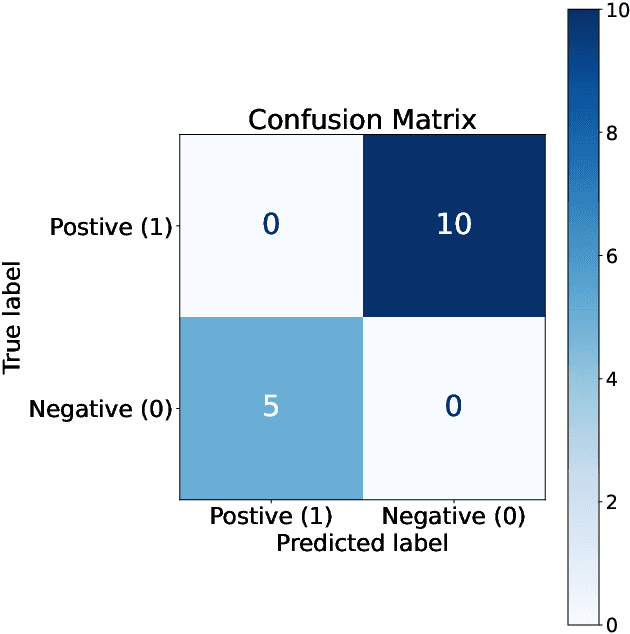
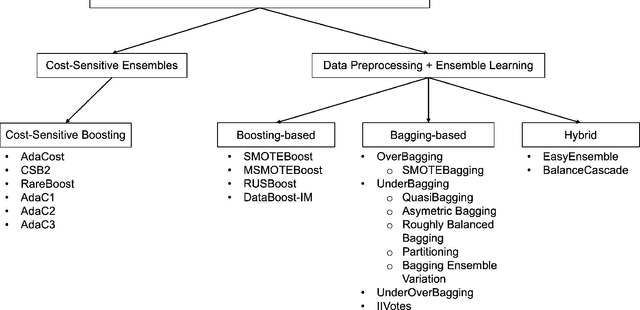
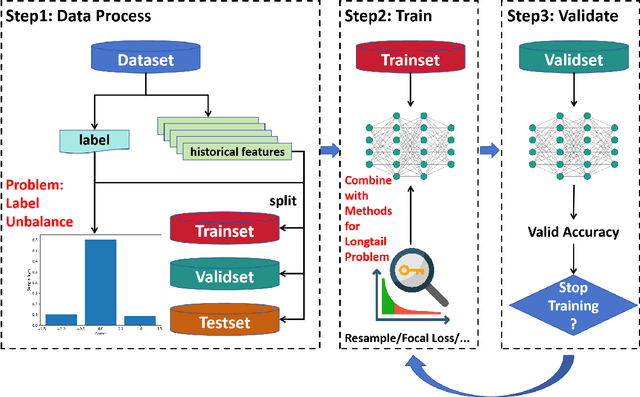
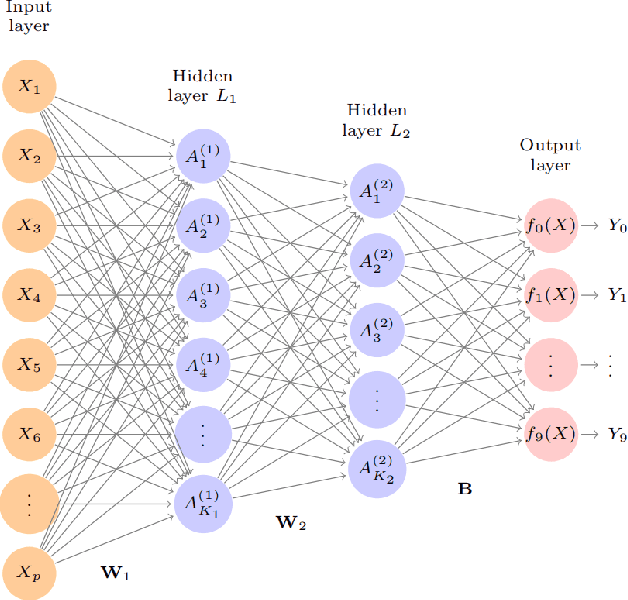
Abstract:In financial trading, return prediction is one of the foundation for a successful trading system. By the fast development of the deep learning in various areas such as graphical processing, natural language, it has also demonstrate significant edge in handling with financial data. While the success of the deep learning relies on huge amount of labeled sample, labeling each time/event as profitable or unprofitable, under the transaction cost, especially in the high-frequency trading world, suffers from serious label imbalance issue.In this paper, we adopts rigurious end-to-end deep learning framework with comprehensive label imbalance adjustment methods and succeed in predicting in high-frequency return in the Chinese future market. The code for our method is publicly available at https://github.com/RS2002/Label-Unbalance-in-High-Frequency-Trading .
First Token Probability Guided RAG for Telecom Question Answering
Jan 11, 2025Abstract:Large Language Models (LLMs) have garnered significant attention for their impressive general-purpose capabilities. For applications requiring intricate domain knowledge, Retrieval-Augmented Generation (RAG) has shown a distinct advantage in incorporating domain-specific information into LLMs. However, existing RAG research has not fully addressed the challenges of Multiple Choice Question Answering (MCQA) in telecommunications, particularly in terms of retrieval quality and mitigating hallucinations. To tackle these challenges, we propose a novel first token probability guided RAG framework. This framework leverages confidence scores to optimize key hyperparameters, such as chunk number and chunk window size, while dynamically adjusting the context. Our method starts by retrieving the most relevant chunks and generates a single token as the potential answer. The probabilities of all options are then normalized to serve as confidence scores, which guide the dynamic adjustment of the context. By iteratively optimizing the hyperparameters based on these confidence scores, we can continuously improve RAG performance. We conducted experiments to validate the effectiveness of our framework, demonstrating its potential to enhance accuracy in domain-specific MCQA tasks.
Mining Limited Data Sufficiently: A BERT-inspired Approach for CSI Time Series Application in Wireless Communication and Sensing
Dec 09, 2024



Abstract:Channel State Information (CSI) is the cornerstone in both wireless communication and sensing systems. In wireless communication systems, CSI provides essential insights into channel conditions, enabling system optimizations like channel compensation and dynamic resource allocation. However, the high computational complexity of CSI estimation algorithms necessitates the development of fast deep learning methods for CSI prediction. In wireless sensing systems, CSI can be leveraged to infer environmental changes, facilitating various functions, including gesture recognition and people identification. Deep learning methods have demonstrated significant advantages over model-based approaches in these fine-grained CSI classification tasks, particularly when classes vary across different scenarios. However, a major challenge in training deep learning networks for wireless systems is the limited availability of data, further complicated by the diverse formats of many public datasets, which hinder integration. Additionally, collecting CSI data can be resource-intensive, requiring considerable time and manpower. To address these challenges, we propose CSI-BERT2 for CSI prediction and classification tasks, effectively utilizing limited data through a pre-training and fine-tuning approach. Building on CSI-BERT1, we enhance the model architecture by introducing an Adaptive Re-Weighting Layer (ARL) and a Multi-Layer Perceptron (MLP) to better capture sub-carrier and timestamp information, effectively addressing the permutation-invariance problem. Furthermore, we propose a Mask Prediction Model (MPM) fine-tuning method to improve the model's adaptability for CSI prediction tasks. Experimental results demonstrate that CSI-BERT2 achieves state-of-the-art performance across all tasks.
LoFi: Vision-Aided Label Generator for Wi-Fi Localization and Tracking
Dec 06, 2024



Abstract:Wi-Fi localization and tracking has shown immense potential due to its privacy-friendliness, wide coverage, permeability, independence from lighting conditions, and low cost. Current methods can be broadly categorized as model-based and data-driven approaches, where data-driven methods show better performance and have less requirement for specialized devices, but struggle with limited datasets for training. Due to limitations in current data collection methods, most datasets only provide coarse-grained ground truth (GT) or limited amount of label points, which greatly hinders the development of data-driven methods. Even though lidar can provide accurate GT, their high cost makes them inaccessible to many users. To address these challenges, we propose LoFi, a vision-aided label generator for Wi-Fi localization and tracking, which can generate ground truth position coordinates solely based on 2D images. The easy and quick data collection method also helps data-driven based methods deploy in practice, since Wi-Fi is a low-generalization modality and when using relevant methods, it always requires fine-tuning the model using newly collected data. Based on our method, we also collect a Wi-Fi tracking and localization dataset using ESP32-S3 and a webcam. To facilitate future research, we will make our code and dataset publicly available upon publication.
KNN-MMD: Cross Domain Wi-Fi Sensing Based on Local Distribution Alignment
Dec 06, 2024



Abstract:As a key technology in Integrated Sensing and Communications (ISAC), Wi-Fi sensing has gained widespread application in various settings such as homes, offices, and public spaces. By analyzing the patterns of Channel State Information (CSI), we can obtain information about people's actions for tasks like person identification, gesture recognition, and fall detection. However, the CSI is heavily influenced by the environment, such that even minor environmental changes can significantly alter the CSI patterns. This will cause the performance deterioration and even failure when applying the Wi-Fi sensing model trained in one environment to another. To address this problem, we introduce a K-Nearest Neighbors Maximum Mean Discrepancy (KNN-MMD) model, a few-shot method for cross-domain Wi-Fi sensing. We propose a local distribution alignment method within each category, which outperforms traditional Domain Adaptation (DA) methods based on global alignment. Besides, our method can determine when to stop training, which cannot be realized by most DA methods. As a result, our method is more stable and can be better used in practice. The effectiveness of our method are evaluated in several cross-domain Wi-Fi sensing tasks, including gesture recognition, person identification, fall detection, and action recognition, using both a public dataset and a self-collected dataset. In one-shot scenario, our method achieves accuracy of 93.26%, 81.84%, 77.62%, and 75.30% in the four tasks respectively. To facilitate future research, we will make our code and dataset publicly available upon publication.
A Remedy to Compute-in-Memory with Dynamic Random Access Memory: 1FeFET-1C Technology for Neuro-Symbolic AI
Oct 20, 2024
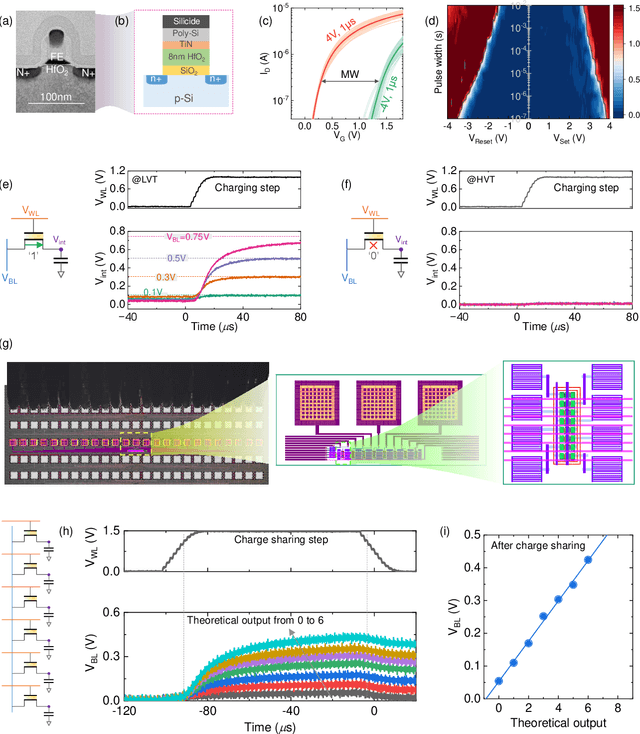
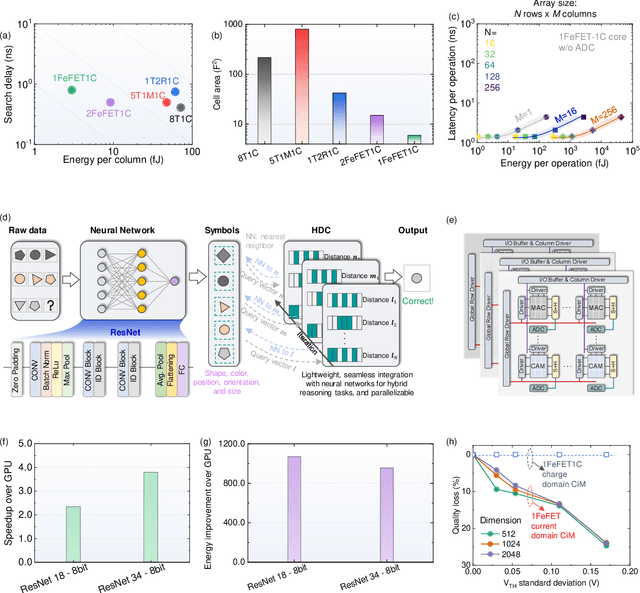
Abstract:Neuro-symbolic artificial intelligence (AI) excels at learning from noisy and generalized patterns, conducting logical inferences, and providing interpretable reasoning. Comprising a 'neuro' component for feature extraction and a 'symbolic' component for decision-making, neuro-symbolic AI has yet to fully benefit from efficient hardware accelerators. Additionally, current hardware struggles to accommodate applications requiring dynamic resource allocation between these two components. To address these challenges-and mitigate the typical data-transfer bottleneck of classical Von Neumann architectures-we propose a ferroelectric charge-domain compute-in-memory (CiM) array as the foundational processing element for neuro-symbolic AI. This array seamlessly handles both the critical multiply-accumulate (MAC) operations of the 'neuro' workload and the parallel associative search operations of the 'symbolic' workload. To enable this approach, we introduce an innovative 1FeFET-1C cell, combining a ferroelectric field-effect transistor (FeFET) with a capacitor. This design, overcomes the destructive sensing limitations of DRAM in CiM applications, while capable of capitalizing decades of DRAM expertise with a similar cell structure as DRAM, achieves high immunity against FeFET variation-crucial for neuro-symbolic AI-and demonstrates superior energy efficiency. The functionalities of our design have been successfully validated through SPICE simulations and prototype fabrication and testing. Our hardware platform has been benchmarked in executing typical neuro-symbolic AI reasoning tasks, showing over 2x improvement in latency and 1000x improvement in energy efficiency compared to GPU-based implementations.
An overview of domain-specific foundation model: key technologies, applications and challenges
Sep 06, 2024Abstract:The impressive performance of ChatGPT and other foundation-model-based products in human language understanding has prompted both academia and industry to explore how these models can be tailored for specific industries and application scenarios. This process, known as the customization of domain-specific foundation models, addresses the limitations of general-purpose models, which may not fully capture the unique patterns and requirements of domain-specific data. Despite its importance, there is a notable lack of comprehensive overview papers on building domain-specific foundation models, while numerous resources exist for general-purpose models. To bridge this gap, this article provides a timely and thorough overview of the methodology for customizing domain-specific foundation models. It introduces basic concepts, outlines the general architecture, and surveys key methods for constructing domain-specific models. Furthermore, the article discusses various domains that can benefit from these specialized models and highlights the challenges ahead. Through this overview, we aim to offer valuable guidance and reference for researchers and practitioners from diverse fields to develop their own customized foundation models.
 Add to Chrome
Add to Chrome Add to Firefox
Add to Firefox Add to Edge
Add to Edge